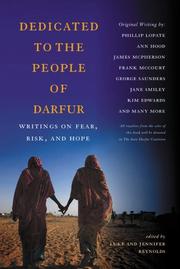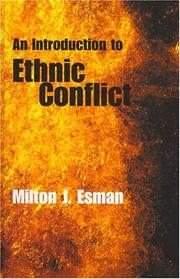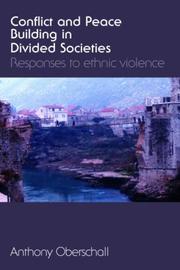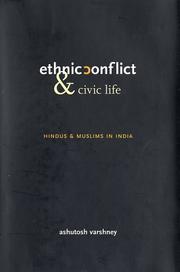| Listing 1 - 10 of 240 | << page >> |
Sort by
|
Book
ISBN: 3869459875 9783869459875 395948223X 9783959482233 9783959482233 Year: 2017 Publisher: Nordhausen, [Germany]
Abstract | Keywords | Export | Availability | Bookmark
 Loading...
Loading...Choose an application
- Reference Manager
- EndNote
- RefWorks (Direct export to RefWorks)
Ethnic conflict. --- Conflict, Ethnic --- Ethnic violence --- Inter-ethnic conflict --- Interethnic conflict --- Ethnic relations --- Social conflict


ISBN: 1283587505 9786613899958 0813548349 9780813548340 9780813546179 0813546176 9780813546186 0813546184 Year: 2009 Publisher: New Brunswick, NJ
Abstract | Keywords | Export | Availability | Bookmark
 Loading...
Loading...Choose an application
- Reference Manager
- EndNote
- RefWorks (Direct export to RefWorks)
Life's changes. They happen every day. Some large, some small. A few are very personal. Others impact the world. Dedicated to the People of Darfur: Writings on Fear, Risk, and Hope includes original and inspiring essays that celebrate the glories gained from taking risks, breaking down barriers, and overcoming any obstacles. Nobel and Pulitzer Prize winners, a gallery of O.Henry award recipients, and many best-selling authors come together to share personal and compelling challenges and experiences. From contemplations on past drug use to reflections on gun control, social justice, passion and its sacrifices, and adventures such as skydiving, mountain climbing, and golfing, the topics vary greatly. This kaleidoscopic anthology is a commentary on the lives of prominent literary artists and ordinary citizens who have made simple, yet powerful choices that provoked change in one's self and for humanityùmuch the same way that Luke and Jennifer Reynolds do by building this invaluable collection for readers and the world of human rights. Not too long ago, as struggling graduate students, Luke and Jennifer Reynolds conceived this uniquely themed volume as a way to raise funds to support ending the genocide in Darfur. Some people carry signs, others make speeches, many take action. What is most special about this book is that it extends beyond words and ideas, into a tangible effort to effect change. To this end, all royalties from the sales of Dedicated to the People of Darfur:Writings on Fear, Risk, and Hope will benefit The Save Darfur Coalition, an organization that seeks to end the genocide in Darfur, Sudan.
Ethnic conflict --- Conflict, Ethnic --- Ethnic violence --- Inter-ethnic conflict --- Interethnic conflict --- Ethnic relations --- Social conflict --- Sudan --- History
Book
ISBN: 1501704885 1501707760 9781501707773 1501707779 9781501707766 1501704877 9781501704871 9781501704871 Year: 2017 Publisher: Ithaca, NY : Cornell University Press,
Abstract | Keywords | Export | Availability | Bookmark
 Loading...
Loading...Choose an application
- Reference Manager
- EndNote
- RefWorks (Direct export to RefWorks)
In Killing Others, Matthew Lange explores why humans ruthlessly attack and kill people from other ethnic communities. Drawing on an array of cases from around the world and insight from a variety of disciplines, Lange provides a simple yet powerful explanation that pinpoints the influential role of modernity in the growing global prevalence of ethnic violence over the past two hundred years. He offers evidence that a modern ethnic mind-set is the ultimate and most influential cause of ethnic violence.Throughout most of human history, people perceived and valued small sets of known acquaintances and did not identify with ethnicities. Through education, state policy, and other means, modernity ultimately created broad ethnic consciousnesses that led to emotional prejudice, whereby people focus negative emotions on entire ethnic categories, and ethnic obligation, which pushes people to attack Others for the sake of their ethnicity. Modern social transformations also provided a variety of organizational resources that put these motives into action, thereby allowing ethnic violence to emerge as a modern menace. Yet modernity takes many forms and is not constant, and past trends in ethnic violence are presently transforming. Over the past seventy years, the earliest modernizers have transformed from champions of ethnic violence into leaders of intercommunal peace, and Killing Others offers evidence that the emergence of robust rights-based democracy-in combination with effective states and economic development-weakened the motives and resources that commonly promote ethnic violence.
Ethnic conflict --- Ethnic conflict. --- Conflict, Ethnic --- Ethnic violence --- Inter-ethnic conflict --- Interethnic conflict --- Ethnic relations --- Social conflict --- History.

ISBN: 0745631169 0745631177 9780745631172 Year: 2004 Publisher: Cambridge Polity press
Abstract | Keywords | Export | Availability | Bookmark
 Loading...
Loading...Choose an application
- Reference Manager
- EndNote
- RefWorks (Direct export to RefWorks)
Sociology of minorities --- Ethnic conflict. --- Ethnic relations --- Political aspects. --- Ethnic conflict --- Ethnic politics --- Conflict, Ethnic --- Ethnic violence --- Inter-ethnic conflict --- Interethnic conflict --- Social conflict --- Political aspects
Book
ISBN: 3769601157 9783769601152 Year: 2001 Volume: 120 Publisher: München Bayerische Akademie der Wissenschaften
Abstract | Keywords | Export | Availability | Bookmark
 Loading...
Loading...Choose an application
- Reference Manager
- EndNote
- RefWorks (Direct export to RefWorks)
Ethnic conflict --- Culture conflict --- Ethnicity --- Conflict, Ethnic --- Ethnic violence --- Inter-ethnic conflict --- Interethnic conflict --- Ethnic relations --- Social conflict --- Ethnology --- Congresses --- Ethnic conflict - Congresses --- Culture conflict - Congresses --- Ethnicity - Congresses

ISBN: 0415411610 0415411602 9780415411615 9780415411608 9780203944851 9781134128099 9781134128136 9781134128143 Year: 2007 Publisher: London Routledge
Abstract | Keywords | Export | Availability | Bookmark
 Loading...
Loading...Choose an application
- Reference Manager
- EndNote
- RefWorks (Direct export to RefWorks)
856 Conflictbenadering --- Ethnic conflict --- Peace-building --- Conflict, Ethnic --- Ethnic violence --- Inter-ethnic conflict --- Interethnic conflict --- Ethnic relations --- Social conflict --- Building peace --- Peacebuilding --- Conflict management --- Peace --- Peacekeeping forces

ISBN: 1281729841 9786611729844 0300127944 9780300127942 9781281729842 9780300085303 0300085303 Year: 2002 Publisher: New Haven
Abstract | Keywords | Export | Availability | Bookmark
 Loading...
Loading...Choose an application
- Reference Manager
- EndNote
- RefWorks (Direct export to RefWorks)
What kinds of civic ties between different ethnic communities can contain, or even prevent, ethnic violence? This book draws on new research on Hindu-Muslim conflict in India to address this important question. Ashutosh Varshney examines three pairs of Indian cities-one city in each pair with a history of communal violence, the other with a history of relative communal harmony-to discern why violence between Hindus and Muslims occurs in some situations but not others. His findings will be of strong interest to scholars, politicians, and policymakers of South Asia, but the implications of his study have theoretical and practical relevance for a broad range of multiethnic societies in other areas of the world as well. The book focuses on the networks of civic engagement that bring Hindu and Muslim urban communities together. Strong associational forms of civic engagement, such as integrated business organizations, trade unions, political parties, and professional associations, are able to control outbreaks of ethnic violence, Varshney shows. Vigorous and communally integrated associational life can serve as an agent of peace by restraining those, including powerful politicians, who would polarize Hindus and Muslims along communal lines.
Communalism --- Ethnic conflict --- Hindus --- Muslims --- Muslims in India --- Conflict, Ethnic --- Ethnic violence --- Inter-ethnic conflict --- Interethnic conflict --- Ethnic relations --- Social conflict --- India --- Politics and government
Book
ISBN: 1617352470 9781617352478 9781607522423 160752242X 9781607522430 1607522438 Year: 2009 Publisher: Charlotte, NC IAP/Information Age Pub.
Abstract | Keywords | Export | Availability | Bookmark
 Loading...
Loading...Choose an application
- Reference Manager
- EndNote
- RefWorks (Direct export to RefWorks)
Multicultural education --- Ethnic conflict --- Conflict management --- School management and organization --- Conflict, Ethnic --- Ethnic violence --- Inter-ethnic conflict --- Interethnic conflict --- Ethnic relations --- Social conflict
Book
ISBN: 900427636X 9789004276369 9789004276352 9004276351 1322515107 Year: 2015 Publisher: Leiden, Netherlands : Brill,
Abstract | Keywords | Export | Availability | Bookmark
 Loading...
Loading...Choose an application
- Reference Manager
- EndNote
- RefWorks (Direct export to RefWorks)
Conflict and Peace in Central Eurasia combines theory with in-depth description and systematic analyses of ethnoterritorial conflict and coexistence in Central Eurasia. Central Eurasia is at the heart of the Eurasian continent around the Caspian Sea. Much of this macro-region is made up of the post-Soviet republics in Central Asia and the Caucasus, but it also covers other areas, such as parts of Russia and Iran. Central Eurasia is subject to a number of ethnoterritorial conflicts. Yet at the same time, a large number of ethnic groups, speaking different languages and following different religions, coexist peacefully in this macro-region. Babak Rezvani explains ethno-territorial conflicts not only by focusing on these conflicts but also by comparing all cases of conflict and coexistence in (post-)Soviet Central Asia, the Caucasus and Fereydan, the so-called Iranian little Caucasus. Aiming at formulating new theories, this book makes use of qualitative comparative analysis (QCA), as well as case studies and statistical analyses. It provides an innovative and interesting contribution to Eurasian Studies and Conflict Analysis, and at the same time demonstrates a detailed knowledge of the relevant literature. Based on thorough research, the study offers a deep and insightful history of the areas and conflicts concerned.
Ethnic conflict --- Conflict, Ethnic --- Ethnic violence --- Inter-ethnic conflict --- Interethnic conflict --- Ethnic relations --- Social conflict --- Eurasia --- Asia --- Europe --- Ethnic relations. --- Conflits ethniques --- Eurasie --- Relations interethniques
Book
ISBN: 1316880141 1316875504 1316877558 1107184207 1316635392 Year: 2019 Publisher: Cambridge, England : Cambridge University Press,
Abstract | Keywords | Export | Availability | Bookmark
 Loading...
Loading...Choose an application
- Reference Manager
- EndNote
- RefWorks (Direct export to RefWorks)
Conflict economics contributes to an understanding of violent conflict and peace in two important ways. First, it applies economic concepts and models to help one understand diverse conflict activities such as war, terrorism, genocide, and peace. Second, it treats coercive appropriation as a fundamental economic activity, joining production and exchange as a means of wealth acquisition. In the second edition of their book Principles of Conflict Economics, Anderton and Carter provide comprehensive, up-to-date coverage of the key themes and principles of conflict economics. Along with new scholarship on well-established areas such as war, terrorism and alliances and under-researched areas including genocides, individual and family aspects of war, and conflict prevention, they apply new economic tools to the study of war and peace such as behavioral economics and economics of identity and offer deeper research and policy insights into how to reconstitute societies after large-scale violence.
War --- Ethnic conflict --- Terrorism --- Peace --- Conflict, Ethnic --- Ethnic violence --- Inter-ethnic conflict --- Interethnic conflict --- Ethnic relations --- Social conflict --- Economics of war --- Competition, International --- War, Cost of --- Economic aspects.
| Listing 1 - 10 of 240 | << page >> |
Sort by
|

 Search
Search Feedback
Feedback About UniCat
About UniCat  Help
Help News
News